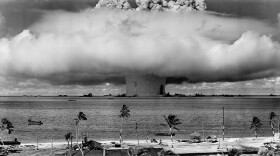A West Texas site wants to get its hands on the nation’s spent nuclear fuel. And if a National Academy of Sciences report is to be believed, this may be safer than the status quo.
Spent nuclear fuel rods are about the width of a Sharpie, a few yards long and deadly for hundreds of thousands of years. And, even after 60 years of commercial nuclear power, the Department of Energy (DOE) has no storage plan.
Waste Control Specialists in Andrews County — currently storing contaminated rags, gloves, and other low-level nuclear waste — submitted an application in April which would allow them to receive high-level spent fuel.
The fuel would sit on-site, entombed in concrete-steel casks, until the DOE comes up with a permanent solution.
“These casks are impressive products of engineering design,” said Erich Schneider, Nuclear Systems Engineer at the University of Texas at Austin.
You can find videos online that show these casks being “propelled by a rocket and then slammed into a concrete wall” at 100 miles per hour and remaining intact, he said.
These 150-ton casks can safely hold the nuclear material for 100 years, and many power-plants are already storing some of their spent fuel on-site in these casks.
But the majority of spent fuel is sits near the reactor in 45-foot deep, industrial grade pools.
Spent fuel is so hot when it comes out of the reactor that it has to sit submerged for a few years before it can be safely transported or even placed in those casks. But, water is actually a really strong radiation shield, Schneider said.
You could probably swim in the pool – if you had to.
“If you stayed near the top you might be alright,” Schneider said.

The Nuclear Regulatory Commission’s (NRC) official stance is that the pools are so safe that there is no reason to spend billions of dollars moving all the spent fuel – the spent fuel cool enough to even move – into the dry-casks.
But the National Academy of Sciences warns that the NRC has under-estimated the risk. In May, the Academy published the final phase of its report on Fukushima and nuclear safety where it recommends “expediting” the spent fuel out of the pools and into the casks.
The pools are more vulnerable to accident or sabotage than the casks, the report states. The pools also hold much more fuel than does an individual cask – just one ruptured pool could cause a devastating radioactive fire capable of contaminating thousands of square miles.
Schneider cautions that such a scenario is remote.
He said it's worth noting that, while a pool failure is extremely high consequence, "those risks are nonetheless small."
The report takes this low-risk into its analysis and still recommends that the NRC re-consider its position.
In Texas there are two nuclear power plants – Comanche Peak, 60 miles from Dallas, started placing spent fuel in casks in 2012. South Texas Nuclear Project, 90 miles from Houston, has plans to start the process in June 2017.
But, according to spokespersons at both these facilities, the cask storage only supplements the pool storage.
The heavily-guarded pools will continue to hold decades worth of spent fuel until the DOE comes up with a permanent storage solution or the NRC changes its guidelines.




